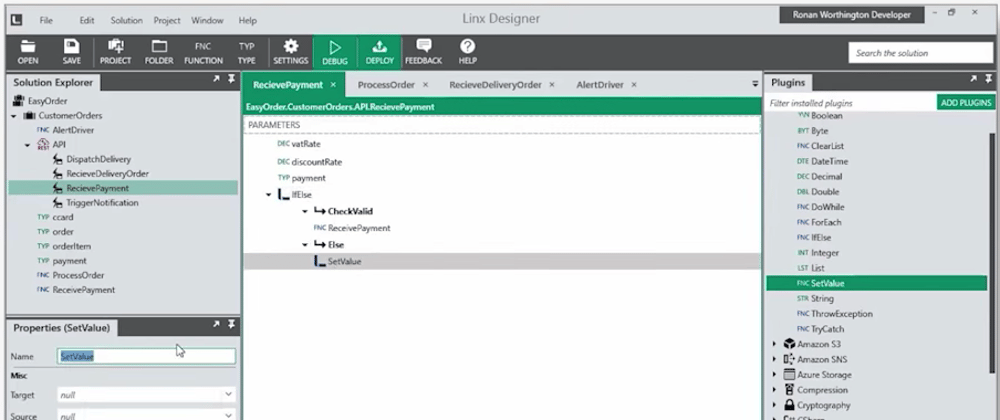Born in the financial markets with 20 years of experience, Linx is a pioneer in the low-code development market. Here’s why….
Low-code continues to gain traction as more businesses learn about the technology’s extensive benefits over traditional coding practices. It allows you to keep the important elements of traditional coding solutions – such as flexibility and customisation – while saving your organisation considerable amounts of time and money.
But not all low-code platforms are created equal.
Low-code, like so much other software jargon, is somewhat ambiguous. Under this umbrella term exists a plethora of various tool types—website generators, form builders, API connectors, database builders, workflow automation and more, each requiring varying levels of technical proficiency.
While most low-code environments tend to use a visual metaphor to describe logical program flow, your ‘diagram’ breaks down very quickly when things get even slightly complicated. Linx follows a free-form functional programming approach, allowing you the tackle the deep complexities of backend development.
Most low code tools target a specific domain or subset of technologies and use a visual process flow to handle custom logic. Linx is a general-purpose platform with no limitations on the technology it can connect to and uses visual abstractions of programming concepts to make building complex logic easy and maintainable.
By sticking to generic programming concepts, Linx has created a unique approach that addresses many of the common pitfalls and limitations of typical low-code platforms.
True Programming Flexibility
A common concern for programmers considering low-code tools is the lack of flexibility. Most low-code tools are based on a workflow paradigm. Linx differs by following a programming paradigm that makes it more all-rounder and easy for developers and IT professionals to pick up.
It does not stipulate a “golden path” or provide templates or any of the process flow concepts offered by many of the other tools. Instead, Linx combines the speed and efficiency of drag and drop functionality with the expressiveness and capabilities of traditional development. By doing so, it covers nearly any scenario or requirement. You can almost say they’re a low-code Visual Studio for backend development.
Programming in a different format
Linx abstracts programming concepts so our tools naturally work like common programming tools. The Linx Designer is an IDE that allows you to program and debug at a higher level and saves the program specification to files deployed to one or more Linx Servers to run the application. Building solutions in Linx should be no different to how you would do it with low-level programming; it’s just with bigger pieces, more visual help and lots of ready-made functionality available on the server-side.
Your Stack Matters
We recognise that very few application development projects start with a clean slate; most have to integrate with existing databases, legacy code, and other applications already in production.
For this very reason, Linx is designed to be “tooling agnostic”, allowing you to combine your business logic with the services of your choice.
The result; fast iterative development, using new or existing resources, and deployment to a production environment with built-in management and monitoring.
How does it compare with other low-code tools
Low-code tools that can be used to build APIs, automations and integrations fall into several broad categories.
...
TOOL CATEGORY
General-purpose low-code platform (Linx)
Best use case: Building APIs, any backend automation or integration.
Not suitable for: Building user interfaces.
Consumer Application Integration (Zapier, IFTTT)
Best use case: Simple automations by non-technical users.
Not suitable for: Anything slightly complex or building APIs.
RPA (UIPath, Automation Anywhere)
Best use case: Automating business processes by automating the user interface.
Not suitable for: Automation or integration where APIs are available or building APIs.
BPM (Kissflow, Creatio)
Best use case: Automating business processes.
Not suitable for: Integrating systems or building APIs
Enterprise Low-code Platforms (Mendix, Outsystems)
Best use case: Building applications.
Not suitable for: Integrating systems or businesses on a budget.
Enterprise Low-code Platforms (Mulesoft, Boomi)
Best use case: Large scale enterprise integration.
Not suitable for: Small to medium automations and integrations
or getting something done quickly.
Extensability
Most low-code tools make working in a specific domain very easy but have difficulties working with systems and concepts that do not form part of the main use-case the tool was designed for. Often (more than not), Linx can fill the gaps when domain-specific low-code tools hit their limits.
Combine Linx with....
Tools like Zapier, IFTTT for complex automation or integration with legacy or on-premise systems.
UIPath, Automation Anywhere for hosting APIs or Microservices for use by the RPA.
Kissflow, Creatio for hosting APIs or microservices for use by the BPM, integration to legacy or unsupported systems and high volume processing.
Mendix, Outsystems for integration to legacy or unsupported systems, building microservices and high volume processing.
Mulesoft, Boomi for integration to legacy or unsupported systems, fast prototyping and microservices.
Today’s competitive environment is driving organisations’ digital transformation. In a fast-paced, ever-changing marketplace, the organisations that cannot keep up will fall behind. Hence, speed to market and speed to change are key competitive differentiators in a digital economy. Linx allows businesses to meet three development imperatives for success in the digital age: Build it fast, build it right (for you!), build for the future.







Top comments (0)